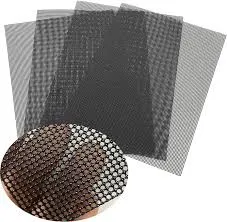-
+86 15030157877
-
sales@galvanizedmetalmesh.com
Th11 . 06, 2024 19:08 Back to list
Durable and Versatile Solutions for Welded Wire Fencing Applications
The Versatility and Benefits of Welded Wire Fences
Welded wire fences are an excellent choice for a variety of applications, from agricultural settings and residential properties to industrial locations. This type of fencing is created by welding together strands of wire, resulting in a sturdy and durable structure that provides security and aesthetics. In this article, we will explore the features, advantages, and various uses of welded wire fences.
What is Welded Wire Fencing?
Welded wire fencing consists of vertical and horizontal wire strands welded together at each intersection, forming a grid-like pattern. The wires are usually made from galvanized steel, which protects against rust and corrosion, ensuring longevity in outdoor environments. While traditional fencing methods can use woven wire meshing, welded wire provides greater strength and stability, making it suitable for heavier use.
Advantages of Welded Wire Fences
1. Durability One of the primary benefits of welded wire fencing is its durability. The welding process creates strong joints that can withstand significant pressure and impact, making it ideal for high-traffic areas and environments where animals may push against the fence.
2. Security With a robust structure, welded wire fences provide an added layer of security. They deter unwanted intruders, whether they are animals trying to break into livestock areas or individuals attempting to access private property. The grid structure makes it harder for animals to gnaw through the fence, ensuring security for pets and livestock.
3. Low Maintenance Compared to other forms of fencing, welded wire fences require minimal maintenance. The galvanized coating protects the wire from rust, and periodic inspections can ensure that the fence remains in good condition. This ease of upkeep can save time and money in the long run.
4. Versatility Welded wire fencing comes in various heights, mesh sizes, and designs, making it adaptable to different applications. Whether it’s a garden enclosure, a livestock pen, or a boundary fence for residential properties, there is a welded wire solution available to fit any need.
welded wire fence

5. Aesthetic Appeal Despite its industrial origins, welded wire fencing can be quite visually appealing. It offers a clean and modern look that can complement landscaping. Additionally, some homeowners choose to add climbing plants or decorative elements to further enhance its appearance.
Common Uses of Welded Wire Fences
1. Agricultural Use Farmers often utilize welded wire fencing for livestock containment, crop protection, and garden enclosures. Its durability ensures that animals remain secure while preventing wildlife from damaging crops.
2. Residential Fencing Homeowners may install welded wire fences around gardens, swimming pools, or yard perimeters. This provides a safe environment for children and pets while also ensuring that plants are protected from animal interference.
3. Industrial Applications In industrial settings, welded wire fences are used for security purposes, including perimeter protection around factories, warehouses, and construction sites. They help prevent unauthorized entry while allowing visibility of the monitored area.
4. Commercial Properties Businesses often opt for welded wire fences as part of their security measures. These fences can delineate property boundaries or protect stored equipment and goods, all while maintaining a visible and professional appearance.
Conclusion
In summary, welded wire fencing is a versatile and effective solution for numerous applications, providing durability, security, and aesthetic appeal. Whether for agricultural, residential, or industrial use, its various benefits make it a popular choice among property owners. If you’re considering fencing options, welded wire could be the ideal choice to meet your needs, ensuring safety, functionality, and style in your environment. By understanding the advantages of this type of fencing, individuals can make informed decisions that enhance their properties while providing essential security and protection.
-
Welded Gabion Solutions: Durable & AI-Enhanced Designs
NewsAug.01,2025
-
Premium Welded Gabion Mesh | Robust & Eco-Friendly
NewsJul.31,2025
-
Premium Eco-Friendly Roof Tiles | Affordable & Durable
NewsJul.31,2025
-
Premium Roof Tiles for Durable & Stylish Roofing Solutions
NewsJul.30,2025
-
High-Quality Roof Tiles for Durable & Stylish Roofing Solutions
NewsJul.29,2025
-
High Quality Square Wire Mesh Manufacturer & Supplier for Wholesale
NewsJul.29,2025



